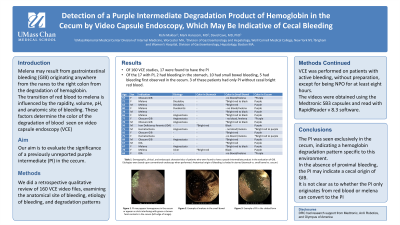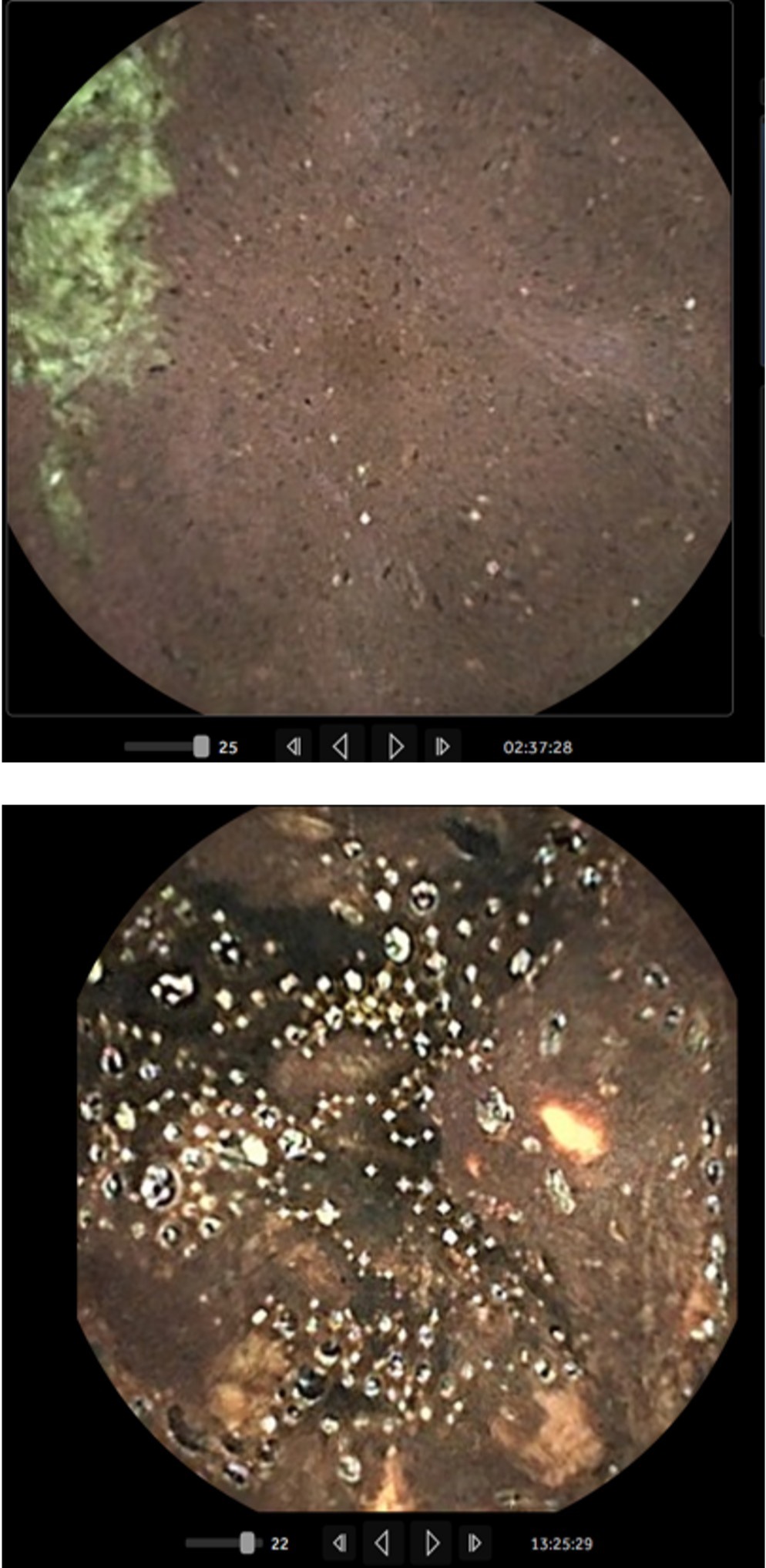Monday Poster Session
Category: GI Bleeding
P2036 - Detection of a Purple Intermediate Degradation Product of Hemoglobin in the Cecum by Video Capsule Endoscopy, Which May Be Indicative of Cecal Bleeding
Monday, October 23, 2023
10:30 AM - 4:15 PM PT
Location: Exhibit Hall

Has Audio

Rishi Makkar
UMass Medical School
Worcester, Massachusetts
Presenting Author(s)
Rishi Makkar, 1, Mark Hanscom, MD2, David R. Cave, MD, PhD3
1UMass Medical School, Worcester, MA; 2Mayo Clinic, Rochester, MN; 3Brigham and Women's Hospital, Boston, MA
Introduction: Melena may result from intestinal bleeding from the nares to the right colon. The degradation of hemoglobin depends on the rapidity of bleeding and the anatomic site or origin. If proximal bleeding is massive, blood may pass through the intestines to the rectum unchanged. In less severe bleeding, blood originating in the stomach or small intestine may turn melenic in the small intestine. We have noted that there is a purple intermediate (PI) in the cecum in some circumstances. We have retrospectively examined video capsule videos of bleeding originating at different sites to establish the conditions under which this intermediate may develop.
Methods: The study was approved by the University of Massachusetts Chan Medical School Institutional Review Board. We retrospectively examined videos from 160 patients with acute gastrointestinal (GI) bleeding looking for the site of bleeding and degradation patterns. The videos were obtained using the Medtronic SB3 capsules and read with RapidReader v 8.3 software. These studies were performed on patients with active bleeding, without preparation, except for being NPO for at least eight hours.
Results: Of 160 patients, 17 showed the PI in the cecum. Of six without small intestinal bleeding (SIB), 2 presented with red blood in the cecum, 1 with melena, and 3 with the PI only. 11 videos of SIB showed red blood or melena in the cecum in 5 and 6 with the PI only. The PI was not seen in the SB in any patient. The PI may appear homogenous in the cecum or appear as clots interfacing with green or brown fecal contents in the cecum—fig 1.
Discussion: We have described a PI in the degradation of hemoglobin that only develops in the cecal environment, that, in the absence of proximal bleeding, may indicate a cecal origin to a gastrointestinal bleed. Although the video capsule is only FDA-approved for the small intestine, its passage into to the cecum and the detection of the PI may afford the opportunity to infer the presence of a cecal bleed.

Disclosures:
Rishi Makkar, 1, Mark Hanscom, MD2, David R. Cave, MD, PhD3. P2036 - Detection of a Purple Intermediate Degradation Product of Hemoglobin in the Cecum by Video Capsule Endoscopy, Which May Be Indicative of Cecal Bleeding, ACG 2023 Annual Scientific Meeting Abstracts. Vancouver, BC, Canada: American College of Gastroenterology.
1UMass Medical School, Worcester, MA; 2Mayo Clinic, Rochester, MN; 3Brigham and Women's Hospital, Boston, MA
Introduction: Melena may result from intestinal bleeding from the nares to the right colon. The degradation of hemoglobin depends on the rapidity of bleeding and the anatomic site or origin. If proximal bleeding is massive, blood may pass through the intestines to the rectum unchanged. In less severe bleeding, blood originating in the stomach or small intestine may turn melenic in the small intestine. We have noted that there is a purple intermediate (PI) in the cecum in some circumstances. We have retrospectively examined video capsule videos of bleeding originating at different sites to establish the conditions under which this intermediate may develop.
Methods: The study was approved by the University of Massachusetts Chan Medical School Institutional Review Board. We retrospectively examined videos from 160 patients with acute gastrointestinal (GI) bleeding looking for the site of bleeding and degradation patterns. The videos were obtained using the Medtronic SB3 capsules and read with RapidReader v 8.3 software. These studies were performed on patients with active bleeding, without preparation, except for being NPO for at least eight hours.
Results: Of 160 patients, 17 showed the PI in the cecum. Of six without small intestinal bleeding (SIB), 2 presented with red blood in the cecum, 1 with melena, and 3 with the PI only. 11 videos of SIB showed red blood or melena in the cecum in 5 and 6 with the PI only. The PI was not seen in the SB in any patient. The PI may appear homogenous in the cecum or appear as clots interfacing with green or brown fecal contents in the cecum—fig 1.
Discussion: We have described a PI in the degradation of hemoglobin that only develops in the cecal environment, that, in the absence of proximal bleeding, may indicate a cecal origin to a gastrointestinal bleed. Although the video capsule is only FDA-approved for the small intestine, its passage into to the cecum and the detection of the PI may afford the opportunity to infer the presence of a cecal bleed.

Figure: Top panel: homogeneous purple intermediate. Bottom Panel: Heterogeneous purple intermediate interfacing with fecal material.
Disclosures:
Rishi Makkar indicated no relevant financial relationships.
Mark Hanscom indicated no relevant financial relationships.
David Cave: AnX Robotica – Grant/Research Support. Medtronic – Consultant. Olympus Corporation of America – Grant/Research Support.
Rishi Makkar, 1, Mark Hanscom, MD2, David R. Cave, MD, PhD3. P2036 - Detection of a Purple Intermediate Degradation Product of Hemoglobin in the Cecum by Video Capsule Endoscopy, Which May Be Indicative of Cecal Bleeding, ACG 2023 Annual Scientific Meeting Abstracts. Vancouver, BC, Canada: American College of Gastroenterology.
